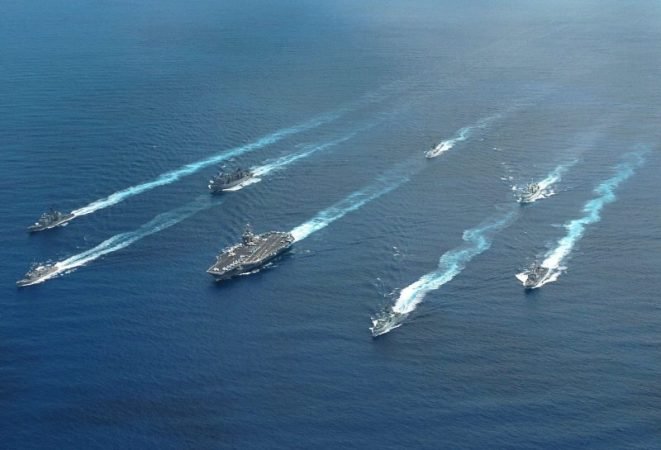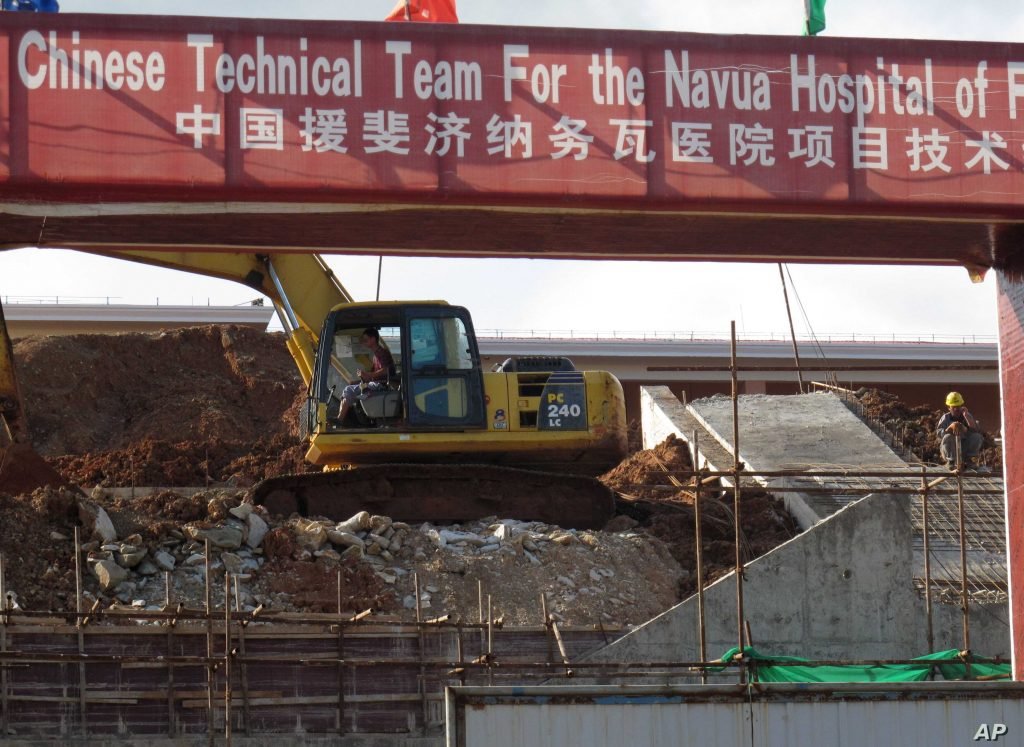Dragon In the backyard of the US: China’s Rise in the South Pacific

In August 2020, a photo of the Chinese Ambassador to Kiribati walking on the backs of the denizens of Kiribati went viral over the internet with claims of racial treatment being meted out to the people of the small pacific island nation. Later, however, it was clarified by the government of Kiribati that the incidence was part of the traditional welcome ceremony long practised by the people of Kiribati and there was nothing wrong with it. The whole incidence had ignited a debate about the interpretation of the local traditions and customs by the outsiders. But another aspect that drew the attention of the geopolitical scholars was the rising footprints of China in the region that has been traditional under the influence of the United States and its allies like Australia.
The South Pacific region, known for its pristine beaches, geographic and cultural diversity and unique development challenges, comprises 14 sovereign nations and seven territories with a cumulative population of over 13 million people. As per a report of the United States Institution of Peace, China has recently emerged as a major diplomatic and economic partner for these remote islands and as economies of this region suffer under Covid, Chinese footprints are only bound to rise given the Chinese grants to the nations in the form of loans and aids. China’s rise in the region is been seen with unease in the policy corridors of the US given the unhindered influence that the US has enjoyed in the region after the 2nd World War. Lately, the United States defence establishment, particularly the US. Indo-Pacific Command has been struggling to make sure that the Chinese do not get a military foothold in the region especially after a report by the US-China Economic and Security Review Commission found in 2018 that a potential Chinese military base or facility comes with “implications for the United States military presence and training in the Indo-Pacific and could pose obstacles to the US Strategic access in the Pacific islands.

Strategic Importance of the Region
Traditionally, the South Pacific Island nations have remained strategically inconsequential in global affairs. But in less than two decades the People’s Republic of China has gained substantial stature in global politics and its growing involvement in world affairs has only caused nausea for some. The Great Game once played by Britain and Russia in the 19th Century for strategic influence in Central Asia is now being played in the South Pacific between the US and China with the potential of changing the strategic balance across Asia and the Indo-Pacific. The growing demand for resources and the global strategic shift to the Asia-Pacific has made nations realise that the small sovereign island states of the region are in control of large resource-rich ocean areas and important Sea Lines Of Communication (SLOC) while commanding more than 48 million square km of Exclusive Economic Zones.
Dragon’s Growing Footprint
It is not that China was completely absent in the region rather it always had some amount of presence. For centuries Chinese residents have operated some of the oldest trading houses of the region (Pryke,2020). However, it is China’s aid, diplomatic and commercial activities in the region after 2006 that has raised concern for the traditional concerns for the traditional powers in the region like the US, Australia and New Zealand. The Pacific island nations having their own sort of development challenges exacerbated by climate change have been long dependent on foreign aid. As per a report of the Lowy Institute, the People’s Republic have pumped in a large amount of money in terms of aids, donations and loans. Between 2006 and 2017 the island nations have collectively received the approximately U.S $1.5 billion from China making it the third-largest donor of the region (Pryke,2020). China has not only used its money to fund large infrastructure projects but also has got critical state-owned enterprises in the island nations. The Pacific has been the central part of China’s led BRI story and the fragile economies of the region have received critical infrastructure funding thus making them highly vulnerable to China’s Debt Trap Diplomacy.

Apart from the grant in aid and other loans China’s presence has also been felt in its increasing economic and trade ties with the countries of this region. Between 2000 and 2012, China saw a tremendous rise in its trade with the nations it had diplomatic ties with. The trade-in this period saw a seven-fold rise from $248 million to $1.767 billion thus making China the second-largest trading partner in the region after Australia. A report issued by the Chinese Ministry of Commerce, according to the 2012 Chinese customs data, claims that the total volume of trade between the Pacific nations and China once $4.5 billion. Besides Chinese markets have been favourite destinations for exports from this region. For example, Solomon Island’s 45 percent of its total exports went to China. Similarly, China has been the largest market for the timbers of Papua New Guinea.
Over a period of time, the Chinese have increased their diplomatic presence in the region despite the fact that bilateral relations have not existed with each of the fourteen island nations. While the western powers like the US, the UK and Germany have gradually lessened their diplomatic corps, the People’s Republic has actually increased the number of its diplomats making it the country with the largest number of diplomats in the region. This has significant foreign policy connotation given the fact that many of the island nations have recognised Taiwan. This diplomatic presence has also paid favourable results for the Communist Party given the fact that in 2019 two important nations of Kiribati and Solomon Islands changed their allegiance from Taiwan to mainland China by denouncing their recognition of Taiwan.
The PLA uses the term ‘military and security cooperation’ for its engagements overseas which includes building all-around military-to-military relations while fulfilling global obligations and responsibilities, as enumerated in the 2015 China’s Military Strategy white paper. The PLA has devoted its attention to the military forces of Fiji, Papua New Guinea and Tonga under its Pacific Island Engagement. Between 2006 and 2019, 24 PLA delegations visited these countries accompanied by naval ships in more than 60 percent of the cases. Apart from non-military loans and aids, the PLA has been extending a significant amount of money to these countries for building military infrastructure and purchasing uniforms and equipment apart from training their armies. Chinese marine research vessels have been very frequent in the region for geological and geographical surveying. This has raised significant concern among the global community about the use of oceanic data for military purpose. Also, some space tracking vessels have made appearances in the region with some scholars arguing that these vessels have the capability for military launches. There have also been reports of China’s deployment of acoustic sensors with the sole aim of monitoring the movement of US submarines along with the use of Chinese fishing boats operating in the Pacific for military surveillance. There has been speculation about the reopening of the Chinese satellite tracking facility on Tarawa island which was closed down in 2003 after Tarawa went on to recognise Taiwan, now that Tarawa has shifted back its allegiance to mainland China. The Pacific Island Nations have the potential to play a significant role in China’s national security policy. China has suffered long in the region for the non-availability of supply depots for its naval ships and enhancing greater cooperation may provide the desired facilities for Chinese naval vessels.
China’s engagement in the region has been multilateral in true senses that it has not invested in the areas of strategic importance but also have engaged with the island nations culturally as well. The Chinese have established Confucius Institutes in the region and have offered courses on the Chinese language and cultures for the students of the University of South Pacific in Fiji. Beijing has distributed roughly 2000 scholarships for the students of the region to study in China besides organising training workshops for the diplomats of the region. The South Pacific nations have seen an increase in the Chinese diaspora because of the Chinese promotion of outdoor migration of its population. The number of the Chinese community is still low compared to the entire population of the region, it has enjoyed significant economic influence in the region.

What drives Chinese engagements in the Region?
There are conflicting views about the Chinese motives behind its growing footprints in the region. For some, Chinese investments in the region is driven by its ambitious plans of rising as hegemonic power by challenging the long enjoyed strategic privileges of the United States and its allies, not only in this region but almost throughout the world. Others, however, are of the opinion that the Chinese rise in the region is a natural outcome of the Chinese economic and commercial needs of fulfilling its resource needs along with promoting what is now being called the South-South Cooperation.
Like any other nation, Chinese interests in the region too has been multifaceted. As far as its core interest in the region is concerned, it is the ‘One China Policy’ which seems to be the main issue here given China’s uncompromising attitude for its ‘territorial integrity and national reunification’. The Pacific island nations have been a real diplomatic battleground for Beijing and Taiwan. While traditionally, the island nations have sided with Taiwan, in recent years more nations have denounced their allegiance for Taiwan and went on to recognise the People’s Republic of China. Kiribati and the Solomon Island have been the recent names giving diplomatic setbacks to Taiwan by recognising the PRC as the real China and denouncing all ties with Taipei. Also, Beijing’s diplomatic and economic investment in the region is driving by the fact that these nations have the potential to act as loyal Chinese allies in international institutions such as the United Nations. Beijing has been regularly pressuring the poor developing nations of the region to regularly counter the condemnation of alleged China’s human rights violation of its minorities
China’s boasting of its maritime power across the Indo-Pacific region, driven by the efforts of the PLA Navy to emerge as a powerful blue water force has been one of the prime reasons for China’s growing interests in this region of the Pacific. Some of the Pacific island nations are directly located in the second and third chains of the coastal defence of China and thus have found strategic importance in the Chinese defence strategy. Some strategic thinkers are of the view that China’s potential military growth in the region comes from the fact that Beijing needs to protect its diaspora in the region. This speculation comes from the fact that there has been a significant rise in the economic interests of the Chinese diaspora. The growing competition between the Chinese and the local business interest might lead to rising of incidents involving the Chinese diaspora in the coming future and thus requiring Chinese evacuation operations in the region
China has been successful in building its stature and influence in the region to a large scale. With the onset of COVID-19 and the relative lag of the Pacific island nation’s economy, China has found itself in a once in a lifetime opportunity to work closely with these nations and further grow its influence in the region. Though China has been closely filling the gap left by the US in recent years, the region still remains strategically important for the US and its allies for the simple reason that the US can not entertain the growth of a regional hegemon in its backyard and also if the free flow of goods and ideas is to be continued, China needs to be checked. The strategic repositioning of the Asia-Pacific to the Indo-pacific regions feature as important strategic geography and has Joanne Wallis of the Australian National University has argued, the South Pacific is going through the building of alternative regional institutions, increased Chinese influence diminished New Zealand and Australian impact and the strategic abandonment of the region by the US.



















